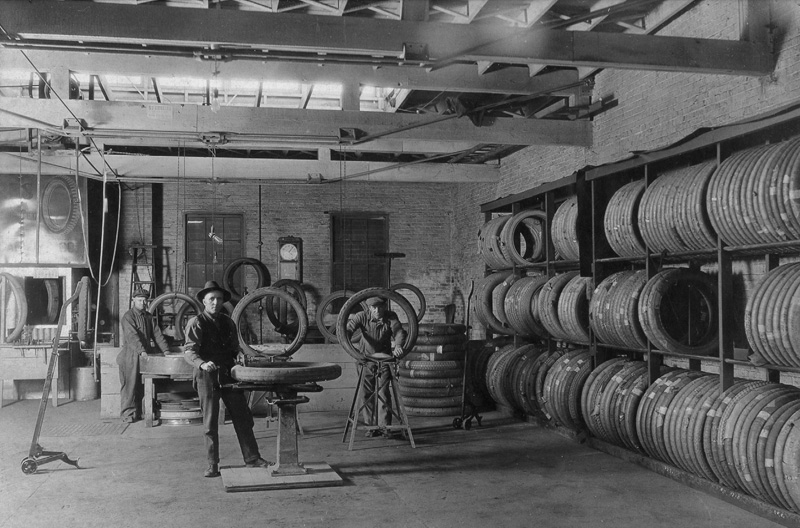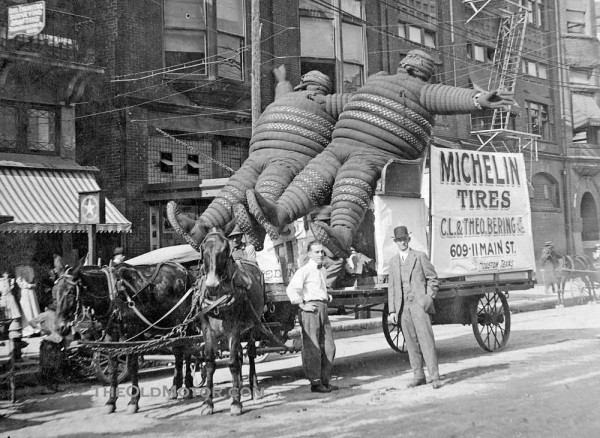A Look Back At The Evolutionary Past Of Tyre

 Now you know why MICHELIN Baby so fatty? :-)
Now you know why MICHELIN Baby so fatty? :-)
现在你知道为什么米其林的吉祥物那么肥了吗? :-)

1892年英国的伯利密尔发明了帘布,1910年用于生产,这一成就除改进了轮胎质量,扩大了轮胎品种外,还使外胎具备了模制的可能性。随着对轮胎质量要求的提高,帘布质量也得到改进,棉帘布由人造丝代替,50年代末人造丝又被强力性能更好、耐热性能更高的尼龙、聚酯帘线所代替,而且钢丝帘线随着子午线轮胎的发展,具有很强的竞争力。
1904年马特创造了炭黑补强橡胶,大规模用于补强胎面胶是在轮胎采用帘布之后,因为在这之前,帆布比胎面在轮胎使用中损坏得还要快,炭黑在胶料中的用量增长很快,30年代每100份生胶中使用的炭黑也不过20份左右,这时主要在胎面上采用炭黑,胎体不用,已达50份以上。胎面中掺用炭黑以前,轮胎大约只行驶6000km就磨光了,掺用炭黑后,轮胎的行驶里程很快就得到显著的提高。一组货车轮胎大约可行驶10万km,在好的路面上,甚至可达20万km。
1913-1926年,因发明了帘线和炭黑轮胎技术,为轮胎工业发展奠定了基础。轮胎外缘的标准化,制造工艺的逐渐完善,生产速度比以前提高了,轮胎的产量与日俱增。
随着汽车工业的发展,轮胎技术一直不断地改进与提高,如20年代初至30年代中期轿车胎由低压轮胎过渡到超低压轮胎;40年代开始轮胎逐步向宽轮辋过渡;40年代末无内胎轮胎的出现;50年代末低断面轮胎问世等等。许多新技术的出现都莫过于1948年法国米西林公司首创的子午线结构轮胎,这种轮胎由于使用寿命和使用性能的显著提高,特别是在行驶中可以节省燃料,而被誉为轮胎工业的革命,在这里简略介绍一下当今发展的主要几种轮胎特征。
早期的汽车使用木制或铁制的车轮,汽车的悬架结构也不完善,再加上路面行驶条件不好,尽管汽车行驶速度不高,但还是颠簸得厉害。有位海军上校对乘坐早期汽车的感受如下追述:“是我初次尝试不用马拉的交通工具。1886年,我乘坐铁轮的汽车在高低不平的花岗石路上行驶,车子的剧烈颠簸使我联想到药水瓶上的说明--服前摇匀”。
第一个空心轮子是1845年英国人罗伯特·汤姆逊发明的,他提出用压缩空气充入弹性囊,以缓和运动时的振动与冲击。尽管当时的轮胎是用皮革和涂胶帆布制成,然而这种轮胎已经显示出滚动阻力小的优点。根据这一原理,1888年约翰·邓录普制成了橡胶空心轮胎,随后托马斯又制造了带有气门开关的橡胶空心轮胎,可惜的是因为内层没有帆布,而不能保持一定的断面形状和断面宽。
橡胶轮胎的出现是汽车进一步发展的先决条件。提到橡胶,人们自然会想到橡胶之父查尔斯·古德伊尔。1834年,他受焦炭炼钢的启发,开始进行软橡胶硬化的试验。经过无数次失败后,在一个偶然的机会,发现了硫化橡胶受热时不发粘而且弹性好,于是硬化橡胶诞生了,橡胶轮胎制造业从此也应运而生。1895年随着汽车的出现,充气轮胎得到广泛的发展,首批汽车轮胎样品是1895年在法国出现的,这是由平纹帆布制成的单管式轮胎, 虽有胎面胶而无花纹。
直到1908年至1912年间,轮胎才有了显著的变化,即胎面胶上有了提高使用性能的花纹,从而开拓了轮胎胎面花纹的历史,并增加了轮胎的断面宽度,允许采用较低的内压,以保证获得较好的缓冲性能。
Thousands of years later, the wheel has come a long way. For one thing it is no longer made of wood and it is guaranteed that the ride is much smoother. What hasn't changed is the fact it is still one of man's greatest inventions. Could you even imagine where we would be today without it?
The early wheel was very simple...a solid curved piece of wood, then leather was eventually added to soften the ride, as time progressed it became solid rubber which led to today's tire--the pneumatic, or air inflated, radial tire.
The first wheels made of metal or wood were very durable but did not provide a very comfortable ride. The nearest thing to the first tire was a metal hoop. There were many individuals that made contributions in creating the tire as we think of it today.
Vulcanization and Charles Goodyear
Rubber was not always as useful as it is today. Early rubber did not hold shape; it would be sticky in hot weather and become inflexible in the cold.
In 1839 Charles Goodyear was credited with the discovery of the vulcanization process. Vulcanization is the process of heating rubber with sulfur. This transforms sticky raw rubber to firm pliable material which makes rubber a perfect material for tires.
The story of Charles Goodyear is a sad one, although he dedicated his entire life to making rubber a better form he would never profit from all his work. Charles Goodyear died bankrupt.
Forty years later a rubber company would honor his hard work by using his name for their new tire company.
Solid Rubber Tires
Soon, after the discovery of vulcanization tires were made out of solid rubber. These tires were strong, absorbed shocks and resisted cuts and abrasions. Although they were a vast improvement, these tires were very heavy and did not provide a smooth ride.
Today there are still types of tires made of solid rubber
Pneumatic Tires
The pneumatic rubber tire uses rubber and enclosed air to reduce vibration and improve traction. Robert W. Thomson, a Scottish engineer, first patented the air filled tire. Unfortunately the idea was too early for its time and was not a commercial success.
In 1888 John Boyd Dunlop of Belfast, Ireland became the second inventor of the pneumatic tire. Dunlop claimed to have no knowledge of Thomsons earlier invention.
The second time around the pneumatic tire caught the publics attention. The timing was perfect because bicycles were becoming extremely popular and the lighter tire provided a much better ride.
Bias Ply Tires
For the next fifty years vehicle tires were made up of an inner tube that contained compressed air and an outer casing. This casing protected the inner tube and provided the tire with traction.
Layers called plys reinforced the casing. The plys were made of rubberized fabric cords that were embedded in the rubber. These tires were known as bias-ply tires. They were named bias ply because the cords in a single ply run diagonally from the beads on one inner rim to the beads on the other. However, the orientation of the cords is reversed from ply to ply so that the cords crisscross each other.
Today you can still find bias-ply tires as authentic equipment for antique and collector cars, as well as for certain type of off-the-road tractor tires.
Radial Tires
The first introduced steel-belted radial tires appeared in Europe in 1948. Radial tires are so named because the ply cords radiate at a 90 degree angle from the wheel rim, and the casing is strengthened by a belt of steel fabric that runs around the circumference of the tire.
Radial tire ply cords are made of nylon, rayon, or polyester. The advantages of radial tires include longer tread life, better steering and less rolling resistance, which increases gas mileage. On the other hand, radials have a harder riding quality, and are about twice as expensive to make.
No comments:
Post a Comment